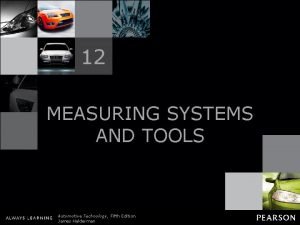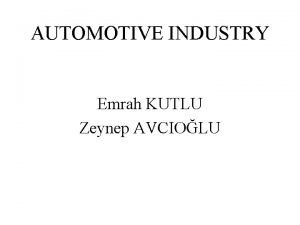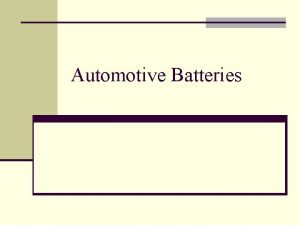Overview of the Indian Automotive Industry Indian Automotive










- Slides: 10

Overview of the Indian Automotive Industry

Indian Automotive Industry – Overview q Indian Automotive industry accounts for 7. 1% of the country’s Gross Domestic Product (GDP) and is expected to emerge as the world’s third-largest passenger vehicle market by 2021. Production Figures (By Segment) ('000) 2017 -18 4, 010 1, 021 2016 -17 3, 801 783 q Kia Motors invested CHF 2 Bn for its manufacturing plant in India and Hyundai to invest CHF 1 Bn by 2020. 2015 -16 3, 465 q As of October 2018, Honda is planning to set up its third factory in India for launching hybrid and EVs with the cost of CHF 1. 31 Bn, its largest investment in India. 2014 -15 3, 221 q The industry is projected to reach CHF 300 Bn by 2026 from CHF 74 Bn in 2017 -18. 934 949 Passenger Vehicles Source: IBEF, Analytics India Magazine, Mckinsey - The future of mobility in India’s passenger-vehicle market 23, 147 894 810 19, 933 18, 830 18, 489 Three Wheelers Two Wheelers 786 698 Commercial Vehicles

Growing income Growth Drivers 3 X increase in average household income from CHF 6, 393 in 2010 to CHF 18, 448 in 2020 Number of Automobiles Produced (million) 23. 36 24. 02 25. 33 FY 15 FY 16 FY 17 29. 07 Youngest Nation' by 2025 India to become the youngest nation by 2025 with an average of 25 years Vehicle penetration Expected to reach 72 vehicles per 1000 people by 2025 FY 18 Number of Automobiles Sold (million) 25. 4 20. 4 21. 1 22. 2 FY 15 FY 16 FY 17 Expanding R&D hub India accounts for 40% of total CHF 31 bn of global engineering and R&D spend. 8% of the country’s R&D expenditure is in the automotive sector Source: Invest India, Grant Thornton – India Auto Industry 2. 0, Indian Machine Tools Industry – Italian Trade Commission FY 18

Recent Investments & Developments Investments are being made by global companies, Indian OEMs, Indian tech firms and, most notably, by various Indian start-ups in the Indian Automotive landscape: Global tier 1 / start-ups Bosch • • Autolabs • • Indian OEMs M&M Tata Motors Indian Tech Firms / Start-ups Ola Cabs Omni. Present Robot Source: IBEF, Grant Thornton – India Auto Industry 2. 0 • • India is one of the three locations of Bosch Center for Artificial Intelligence (BCAI): Around 18, 000 of Bosch’s 31, 000 associates in India work in R&D In 2017, Bosch invested EUR 300 million in its BCAI across three continents – one of the main locations being in Bengaluru, India German start-up German Autolabs is putting its digital driving assistant ‘Chris’ into Indian cars A voice-controlled digital assistant that allows drivers to make phone calls, send messages, listen to music and get navigation without touching their smartphones Development of autonomous vehicles in India is being spearheaded by key local automakers, such as Mahindra & Mahindra and Tata Motors There are currently more than 25 R&D centers within the Indian auto sector, which accounts for about 10% of domestic R&D expenditure • Ola has raised $1. 1 billion to invest in AI and ML capabilities • Omni. Present Robot is one of India’s leading robotics manufacturer, which manufactures drones for industrial inspections, as well as driverless cars

National Electric Mobility Mission Plan (NEMMP) 2020 Key Initiatives Automotive Mission Plan (2016 -2026) Parameter Target 2020 Revenue CHF 260 billion to CHF 300 billion Production 6 -7 million units/year with a full range of EVs (x. EVs) Total production for commercial vehicles 2. 0 - 3. 9 million units Fuel savings 2. 2 – 2. 5 million tons Sale of passenger vehicles 9. 4 - 13. 4 million units CO 2 emissions 1. 3% to 1. 5% Sale of 2 -wheelers 50. 6 - 55. 5 million R&D spend CHF 1. 8 billion – CHF 2 billion Jobs Created 65 million Contribution to GDP 12% Exports 35%-40% of overall output AMP 2016 -2026 is focused on strategies for enhanced automotive growth, contribution to GDP, minimizing carbon footprints and attaining high level of technological competence. Source: IBEF, Grant Thornton – India Auto Industry 2. 0 Impact • Companies like M&M, Tata Motors, Maruti Suzuki, Ashok Leyland, Hyundai, Tata Motors, Hero Motors Corp & Honda are at various stages of developing the various types of EVs • Recently, the Indian Space Research Organization (ISRO) has signed an Mo. U with BHEL to set up a production plant of low-cost Li-ion batteries for EVs

Indian Automotive Industry - Opportunities Electrification Connected Vehicles Shared Mobility Ø India’s EV market has just taken off, and is miniscule compared with markets in China, Europe and the United States Ø Expected EV penetration in India by 2030: Ø Connectivity is still in the early stages of adoption in India Ø Small percentage of vehicles sold in India comes with factory-fitted connectivity features, but the mass adoption of smartphones, coupled with low data costs, could enable connectivity features to proliferate Ø The connected vehicle market in India is expected to witness a CAGR of 13% to reach CHF 2 Bn by 2024 Ø Penetration of shared mobility in India remains low compared with China and the United States but a major shift is under way in densely populated cities where the use of e-hailing cabs costs less 0 -5% • Medium and heavy commercial vehicles • Light commercial vehicles over 3. 5 tonnes • Construction equipment 15 25% • Light commercial vehicles under 3. 5 tonnes • Motorcycles over 125 cc • Midsize cars & compact UVs 25 35% • • Motorcycles under 125 cc Scooters, mopeds and three wheelers Premium & luxury cars and buses Light commercial passenger vehicles Source: IBEF, Analytics India Magazine, Mckinsey - The future of mobility in India’s passenger-vehicle market Ø Shared mobility fleet in India is expected to reach 4. 7 million units by 2025

Indian Electric Vehicles Market – Overview Targets • E-Mobility in India can be categorized into 4 markets: 2 Wheelers (2 Ws), 3 -Wheelers (3 Ws), 4 Wheelers (4 Ws) and Electric Buses 1 Public transport fleet 100% electric by 2030 2 2700+ charging stations by 2022 • The EV ecosystem in India is in its nascent stage 3 4 • EV industry is dominated by 3 -Wheelers and is expected grow at a CAGR of 35% by 2023 40% passenger fleet electric by 2040 12% GST on EVs vs. 28% GST on petrol & diesel vehicles • Currently less than 400 public EV chargers installed of which more than 90% of which are AC slow chargers Segment • ~15 firms currently supplying EV chargers in India Electric Two-Wheelers 126, 000 54, 800 Electric Three-Wheelers 630, 000 NA Electric Passenger Cars 3, 600 1, 200 EVs sold through 2030 could cumulatively save 474 million tonnes of oil and generate CO 2 savings of 846 million tonnes Source: Economic Times, Niti Aayog and Live Mint Current Level of EV Penetration (Units) FY 2019 FY 2018

Indian Electric Vehicles Market – FAME India Initiative • Indian Government launched Faster Adoption and Manufacturing of Electric Vehicles (FAME) India, a CHF 2 billion project, in 2015 to promote eco-friendly vehicles • FAME is a two phased incentive-based program aimed at promoting electric mobility in India by offering Monetary & Fiscal incentives to manufacturers • • • Incentives for 2 Ws: CHF 25 – 420 Incentives for 3 Ws: CHF 50 – 870 Incentives for 4 Ws: CHF 185 – 2700 Results Targets Phase 1 (April 2015 to March 2019) • • • 100+ models identified for subsidies 56, 000 EV units sold in 2018 (124% increase from 2017 at 25, 000 units) Import duty on batteries cut to 4% from 26% Targets Phase 2 (April 2019 to March 2022) • • A budget of CHF 1. 4 billion allocated Charging stations to be set up at every 25 km along major highways Run test projects and pilots Promoting the use of EVs Indigenous Charging Standards in India • Bureau of Indian Standards (BIS) & Department of Science & Technology (DST) are working on indigenous charging standards for EVs • Currently three acceptable global standards – Japanese, Chinese and European • Charging station companies to no longer buy license, reducing the cost significantly

Indian Electric Vehicles Market – Opportunities EV Volume Breakdown (2018) Range of EVs • The range of 200 -250 km offered by EVs is nearly half of what is exhibited by petrol and diesel-based vehicles • The charging time taken by EVs ranges from 6 -8 hours which adds on to the resistance to buy EVs • India heavily relies on the imports from China, Korea and Taiwan for lithium-ion batteries for EVs 1% 16% 83% Three Wheelers Four Wheelers Two Wheelers Source: Economic Times, Niti Aayog and Live Mint make up to about 40% of the cost of the vehicle and Lack of Battery • Batteries cost about CHF 275/k. Wh in India as opposed to CHF 170/k. Wh Manufacturers in the US Lack of Associated Infrastructure • Indian government is pushing companies to manufacture batteries in India to reduce the cost of EVs • Policy uncertainty is affecting the development of associated infrastructural support for the industry. • The lack of clarity over AC versus DC charging stations, grid stability and range anxiety hinder the growth of EV Industry

THANK YOU
 Automotive measuring tools
Automotive measuring tools Slovenia automotive industry
Slovenia automotive industry Automotive industry
Automotive industry The automotive industry in the era of sustainability
The automotive industry in the era of sustainability Why consulting
Why consulting Telecom industry overview
Telecom industry overview Apple industry overview
Apple industry overview Introduction to icici bank
Introduction to icici bank Indian plastic industry analysis
Indian plastic industry analysis Problem of leasing
Problem of leasing Thế nào là mạng điện lắp đặt kiểu nổi
Thế nào là mạng điện lắp đặt kiểu nổi



















